-
Design and implementation
- Is the stage in the software engineering process at which an executable software system is developed.
- activities are invariably inter-leaved.
- Design is a creative activity in which you identify software components and their relationships, based on a customer’s requirements.
- Implementation is the process of realizing the design as a program.
-
Object-oriented design using the UML
-
Context and interaction models
- A system context model is:
- a structural model that demonstrates the other systems in the environment of the system being developed.
- An interaction model is:
- a dynamic model that shows how the system interacts with its environment as it is used.
System context for the weather station

- Design models show the objects & object classes and relationships between these entities. E.g.
- 1. Control system has many weather station, and each weather station only has one control system.
- 2. Weather information system has one satellite and each satellite only has one weather information system.
- 3. Each weather station has one satellite and each satellite has many weather station.
An object-oriented design process
- Structured object-oriented design processes
- Involve developing a number of different system models.
- Require a lot of effort for development and maintenance of these models and, for small systems, this may not be cost-effective.
- However, for large systems developed by different groups design models are an important communication mechanism.
Process stages
- There are a variety of different object-oriented design processes that depend on the organization using the process.
- Common activities in these processes include:
- Define the context and modes of use of the system;
- Design the system architecture;
- Identify the principal system objects;
- Develop design models;
- Specify object interfaces.
- Process illustrated here using a design for a wilderness weather station.
System context and interactions
- Understanding the relationships between the software that is being designed and its external environment is essential for deciding:
- how to provide the required system functionality, and
- how to structure the system to communicate with its environment.
- Understanding of the context also lets you establish the boundaries of the system. Setting the system boundaries helps you decide:
- what features are implemented in the system being designed, and
- what features are in other associated systems.
-
Use case description—Report weather
System Weather station Use case Report weather Actors Weather information system, Weather station Description The weather station sends a summary of the weather data that has been collected from the instruments in the collection period to the weather information system. The data sent are the maximum, minimum, and average ground and air temperatures; the maximum, minimum, and average air pressures; the maximum, minimum, and average wind speeds; the total rainfall; and the wind direction as sampled at five-minute intervals. Stimulus The weather information system establishes a satellite communication link with the weather station and requests transmission of the data. Response The summarised data is sent to the weather information system. Comments Weather stations are usually asked to report once per hour but this frequency may differ from one station to another and may be modified in the future. Weather station use cases

-
How to design computer architecture for wilderness weather station?
- Step 1: Once interactions between the systems and its environment have been understood, you use this information for designing the system architecture.
- Step 2: You identify the major components that make up the system and their interactions, and then may organize the components using an architectural pattern such as a layered or client-server model.
- Step 3: The weather station is composed of independent subsystems that communicate by broadcasting messages on a common infrastructure.
Architecture of data collection system

High-level architecture of the weather station

-
Object class identification
- Identifying object classes is difficult part of object oriented design.
- There is no 'magic formula' for it.
- It relies on the skill, experience and domain knowledge of system designers.
- It is an iterative process. You are unlikely to get it right first time.
How to identification object classes?
- Use a grammatical approach based on a natural language description of the system.
- Base the identification on tangible things in the application domain.
- Use a behavioural approach and identify objects based on what participates in what behaviour.
- Use a scenario-based analysis. The objects, attributes and methods in each scenario are identified.
Weather station object classes
- Object class identification in the weather station system may be based on the tangible hardware and data in the system:
- Ground thermometer, Anemometer, Barometer
- Application domain objects that are ‘hardware’ objects related to the instruments in the system.
- Weather station
- The basic interface of the weather station to its environment. It therefore reflects the interactions identified in the use-case model.
- Weather data
- Encapsulates the summarized data from the instruments.
Weather station object classes
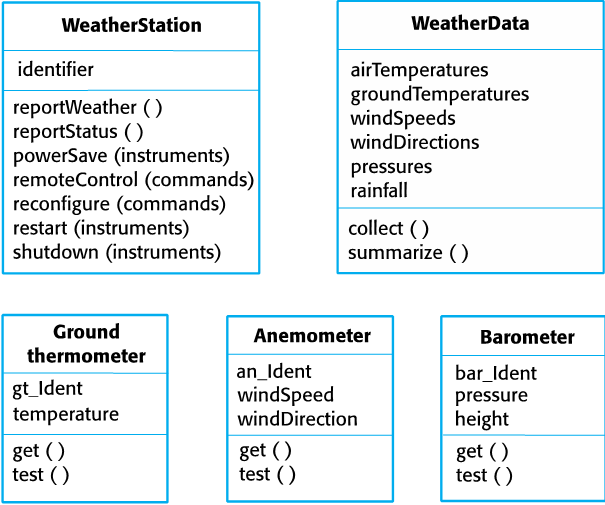
Design models
- Design models show the objects and object classes and relationships between these entities.
- There are two kinds of design model:
- Structural models describe the static structure of the system in terms of object classes and relationships.
- Dynamic models describe the dynamic interactions between objects.
Examples of design models
- Subsystem models that show logical groupings of objects into coherent subsystems.
- Sequence models that show the sequence of object interactions.
- State machine models that show how individual objects change their state in response to events.
- Other models include use-case models, aggregation models, generalisation models, etc.
-
Design patterns
-
Design and Implementation
- Implementation issues
- Open source development
Useful link
- 📹 What is open source?
Implementation issues
- Focus here is not on programming, although this is obviously important, but on other implementation issues that are often not covered in programming texts:
- Reuse Most modern software is constructed by reusing existing components or systems. When you are developing software, you should make as much use as possible of existing code.
- Configuration management During the development process, you have to keep track of the many different versions of each software component in a configuration management system.
- Host-target development Production software does not usually execute on the same computer as the software development environment. Rather, you develop it on one computer (the host system) and execute it on a separate computer (the target system).
Useful link
- 📹 Work smarter with configuration management. Part 1: Introduction
Design patterns
- It is a way of reusing abstract knowledge about a problem and its solution.
- A pattern is a description of the problem and the essence of its solution.
- It should be sufficiently abstract to be reused in different settings.
- Pattern descriptions usually make use of object-oriented characteristics such as inheritance and polymorphism.
Patterns
- Patterns and Pattern Languages are ways to describe:
- best practices,
- good designs, and
- capture experience in a way that it is possible for others to reuse this experience.
Useful link:
- 📹 Design pattern-introduction
Key points
- Software design and implementation are inter-leaved activities. The level of detail in the design depends on the type of system and whether you are using a plan-driven or agile approach.
- The process of object-oriented design includes
- activities to design the system architecture, identify objects in the system,
- describe the design using different object models and document the component interfaces.
- A range of different models may be produced during an object-oriented design process. These include
- static models (class models, generalization models, association models) and
- dynamic models (sequence models, state machine models).
XXX -
Reuse
- From the 1960s to the 1990s, most new software was developed from scratch, by writing all code in a high-level programming language.
- The only significant reuse or software was the reuse of functions and objects in programming language libraries.
- Costs and schedule pressure mean that this approach became increasingly unviable, especially for commercial and Internet-based systems.
- An approach to development based around the reuse of existing software emerged and is now generally used for business and scientific software.
Reuse levels
- The abstraction level
- At this level, you don’t reuse software directly but use knowledge of successful abstractions in the design of your software.
- The object level
- At this level, you directly reuse objects from a library rather than writing the code yourself.
- The component level
- Components are collections of objects and object classes that you reuse in application systems.
- The system level
- At this level, you reuse entire application systems.
Software reuse
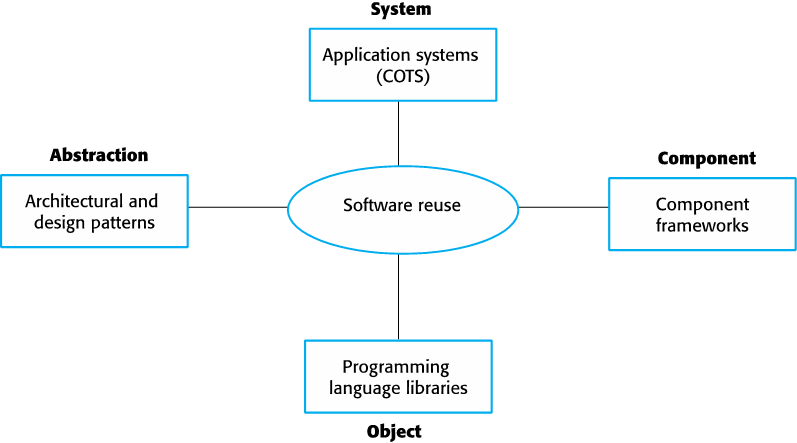
Reuse costs
- The costs of the time spent in looking for software to reuse and assessing whether or not it meets your needs.
- Where applicable, the costs of buying the reusable software. For large off-the-shelf systems, these costs can be very high.
- The costs of adapting and configuring the reusable software components or systems to reflect the requirements of the system that you are developing.
- The costs of integrating reusable software elements with each other (if you are using software from different sources) and with the new code that you have developed.
-
Configuration management activities
- Version management, where support is provided to keep track of the different versions of software components. Version management systems include facilities to coordinate development by several programmers.
- System integration, where support is provided to help developers define what versions of components are used to create each version of a system. This description is then used to build a system automatically by compiling and linking the required components.
- Problem tracking, where support is provided to allow users to report bugs and other problems, and to allow all developers to see who is working on these problems and when they are fixed.
Configuration management tool interaction
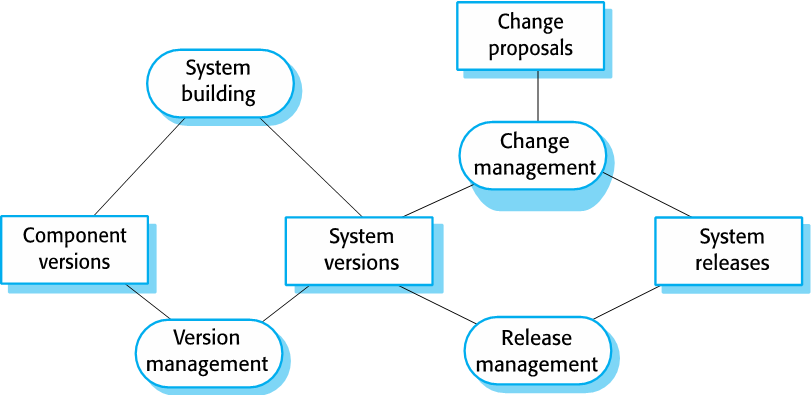
-
Host-target development
- Most software is developed on one computer (the host), but runs on a separate machine (the target).
- More generally, we can talk about a development platform and an execution platform.
- A platform is more than just hardware.
- It includes the installed operating system plus other supporting software such as a database management system or, for development platforms, an interactive development environment.
- Development platform usually has different installed software than execution platform; these platforms may have different architectures.
Host-target development
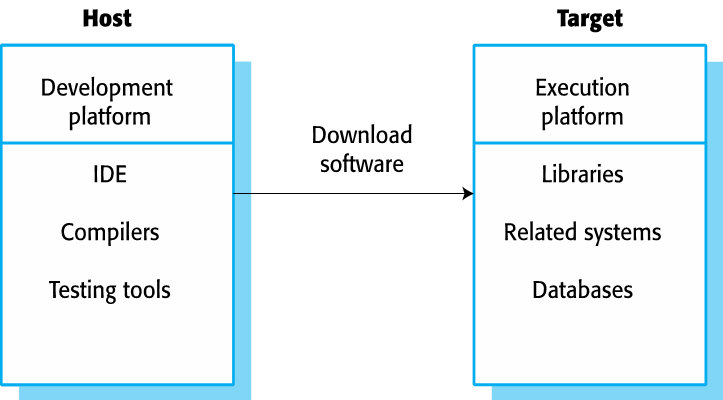
Development platform tools
- An integrated compiler and syntax-directed editing system that allows you to create, edit and compile code.
- A language debugging system.
- Graphical editing tools, such as tools to edit UML models.
- Testing tools, such as Junit that can automatically run a set of tests on a new version of a program.
- Project support tools that help you organize the code for different development projects.
- “JUnit is a unit testing framework for Java programming language. JUnit has been important in the development of test-driven development, and is one of a family of unit testing frameworks collectively known as xUnit, that originated with Junit”. Data source: http://www.tutorialspoint.com/junit/
Integrated development environments (IDEs)
- Software development tools are often grouped to create an integrated development environment (IDE).
- An IDE is a set of software tools that supports different aspects of software development, within some common framework and user interface.
- IDEs are created to support development in a specific programming language such as Java. The language IDE may be developed specially, or may be an instantiation of a general-purpose IDE, with specific language-support tools.
Component/system deployment factors
- If a component is designed for a specific hardware architecture, or relies on some other software system, it must obviously be deployed on a platform that provides the required hardware and software support.
- High availability systems may require components to be deployed on more than one platform.
- This means that, in the event of platform failure, an alternative implementation of the component is available.
- If there is a high level of communications traffic between components, it usually makes sense to deploy them on the same platform or on platforms that are physically close to one other.
- This reduces the delay between the time a message is sent by one component and received by another.
-
Open source development
-
Open source licensing
- A fundamental principle of open-source development is that source code should be freely available, this does not mean that anyone can do as they wish with that code.
- Legally, the developer of the code (either a company or an individual) still owns the code. They can place restrictions on how it is used by including legally binding conditions in an open source software license.
- Some open source developers believe that if an open source component is used to develop a new system, then that system should also be open source.
- Others are willing to allow their code to be used without this restriction. The developed systems may be proprietary and sold as closed source systems.
License models
- The GNU General Public License (GPL). This is a so-called ‘reciprocal’ license that means that if you use open source software that is licensed under the GPL license, then you must make that software open source.
- The GNU Lesser General Public License (LGPL) is a variant of the GPL license where you can write components that link to open source code without having to publish the source of these components.
- The Berkley Standard Distribution (BSD) License. This is a non-reciprocal license, which means you are not obliged to re-publish any changes or modifications made to open source code. You can include the code in proprietary systems that are sold.
License management
- Establish a system for maintaining information about open-source components that are downloaded and used.
- Be aware of the different types of licenses and understand how a component is licensed before it is used.
- Be aware of evolution pathways for components.
- Educate people about open source.
- Have auditing systems in place.
- Participate in the open source community.
Open source development
- Open source development is an approach to software development in which the source code of a software system is published and volunteers are invited to participate in the development process
- Its roots are in the Free Software Foundation (www.fsf.org), which advocates that source code should not be proprietary but rather should always be available for users to examine and modify as they wish.
- Open source software extended this idea by using the Internet to recruit a much larger population of volunteer developers. Many of them are also users of the code.
Useful link
- 📹 Open Source Software
Open source systems
- The best-known open source product is, of course, the Linux operating system which is widely used as a server system and, increasingly, as a desktop environment.
- Other important open source products are Java, the Apache web server and the mySQL database management system.
Open source issues
- Should the product that is being developed make use of open source components?
- Should an open source approach be used for the software’s development?
Open source business
- More and more product companies are using an open source approach to development.
- Their business model is not reliant on selling a software product but on selling support for that product.
- They believe that involving the open source community will allow software to be developed more cheaply, more quickly and will create a community of users for the software.
X -
Key Points
- When developing software, you should always consider the possibility of reusing existing software, either as components, services or complete systems.
- Configuration management is the process of managing changes to an evolving software system. It is essential when a team of people are cooperating to develop software.
- Most software development is host-target development. You use an IDE on a host machine to develop the software, which is transferred to a target machine for execution.
- Open source development involves making the source code of a system publicly available. This means that many people can propose changes and improvements to the software.
-
First Year Case Study
-
The JavaDB Database Tables
- The JavaDB database has Four tables to support the saving of instances of the User, Booking, Tour and Package classes
- The tables are:
- USERS for instances of the User class
- TOURS for instances of the Tour class
- BOOKINGS for instances of the Booking class
- PACKAGES for instance of the Package class
- A single row in each table is used to hold each class instance.
- 📷 Design Model 1 Domain Classes
- 📷 Design Model 2 Commands
- Behavioural patterns – Describe how objects interact and distribute responsibility E.g. Command pattern
Objectives
- To introduce the first year case study.
- To study the Use Case model.
- To study the case study architecture.
- To consider the analysis model.
- To consider the domain classes.
- To view the JavaDB Database tables.
- To study the design model.
- To execute and use the case study.
The First Year Case Study
- The case study is a simple 3-tier Web application.
- The application is an E-Commerce application that might be used by a travel company to allow the booking of travel tours.
- Case study clients are thin e.g. a Firefox or Internet Explorer Web browser.
- The middle tier is implemented using Java technology and is responsible for Presentation, Business and Data Access Logic.
- The middle tier uses a server called Tomcat that can serve Web pages and can also execute code in response to client requests.
- The JavaDB database server is the third tier
- 📷 The Use Case Model
- 📷 The Analysis Model (icon)
- 📷 The Analysis Model (non icon)
- 📷 The Domain Classes
X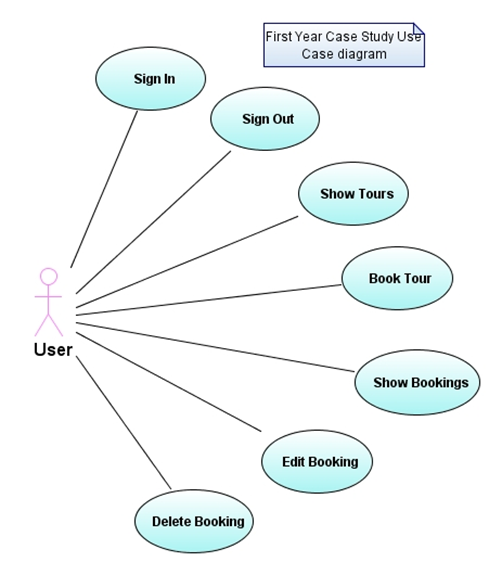 X
X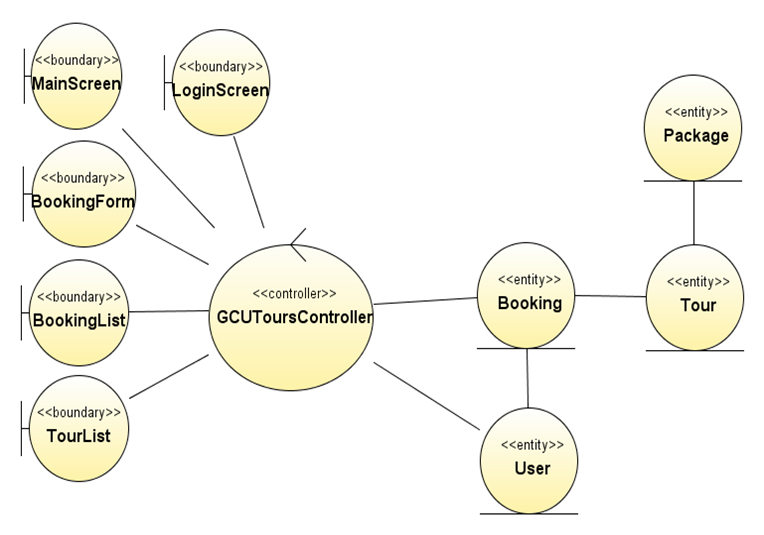 X
X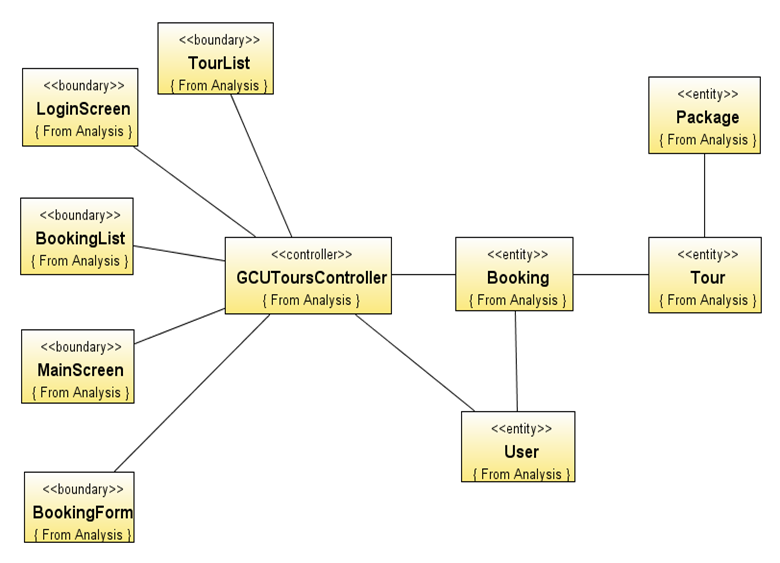 X
X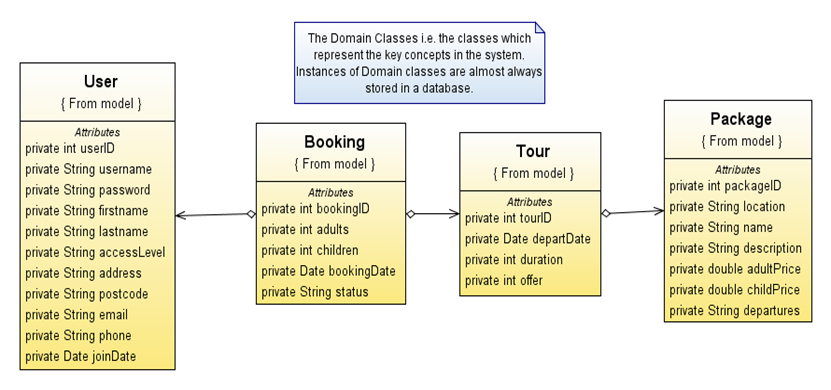 X
X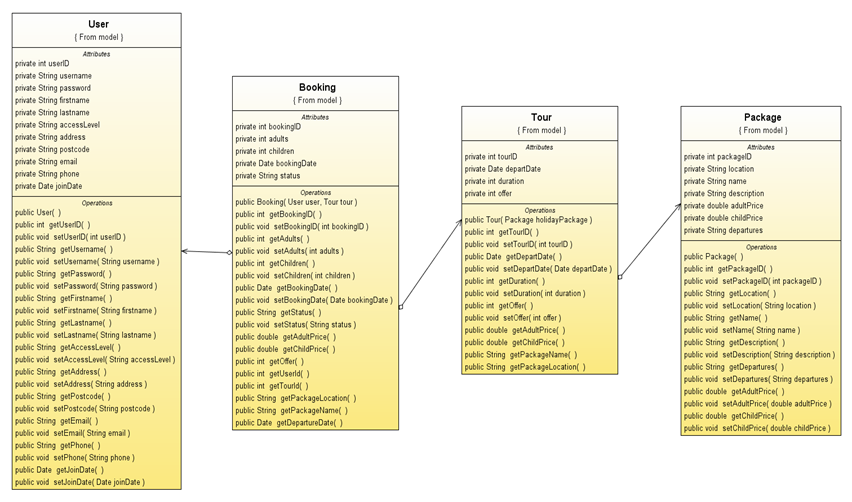 X
X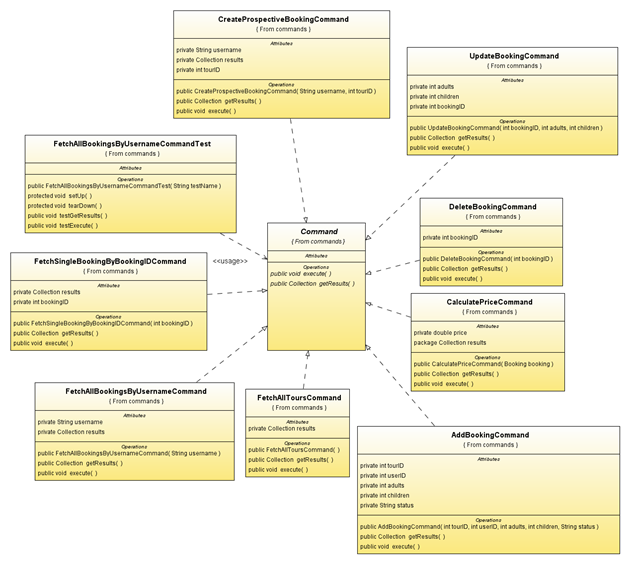
-
Applying the Command Pattern: Consequences
- Advantages:
- Reduces complexity of decision logic
- Provides easy extensibility
- Can readily provide for undo operations
- Can place multiple commands on a queue
- Can execute commands in separate threads or remotely
- Disadvantages:
- Might increase overhead in object creation, destruction, and use
- Makes the structure of an application more complex
Q 1. write down suitable pattern(s) for each case:
- 1. which pattern is used to implement login system and transaction system?
- A: Command
- 2. which pattern is used to bank transaction system?
- A: Command
Polymorphism
- Polymorphism allows invocation of operations of specific objects through generic references
- Aspects of polymorphism:
- A variable can be assigned different types at runtime
- Method implementation is determined by the object type, not the reference type
- Advantages:
- Enables you to write generic code that does not depend upon a specific subclass
- Allows you to code fewer methods because a supertype can be specified as the parameter type
Applying the Command Pattern: Problem Forces
- Useful when the client class needs to be separated from how that request is executed:
- There needs to be an easy way to dynamically add new actions and modify existing actions
- The client should be simple
- The client should not need to know the mechanics of handling a specific requests
- The interface to carry out requests should be simple
- Undo and redo previously executed actions
- Execute commands asynchronously, remotely, or in a different thread
Applying the Command Pattern: Solution
- Each action is implemented in the execute method of its own class that implements the Command interface
- The client creates the necessary SpecificCommand object and passes it to an Invoker object
- The Invoker object has no knowledge of what SpecificCommand does, it simply invokes the execute method
- 📷 Command Pattern Structure
- Implementation strategies include:
- The SpecificCommand can also contain state data relating to the command
- The SpecificCommand can either implement the action itself or call other objects to do the work
- The Command interface can also include an undo method
- The Invoker can be in a separate thread, process, or server from the Client
- The Invoker can queue the actions and execute them asynchronously
X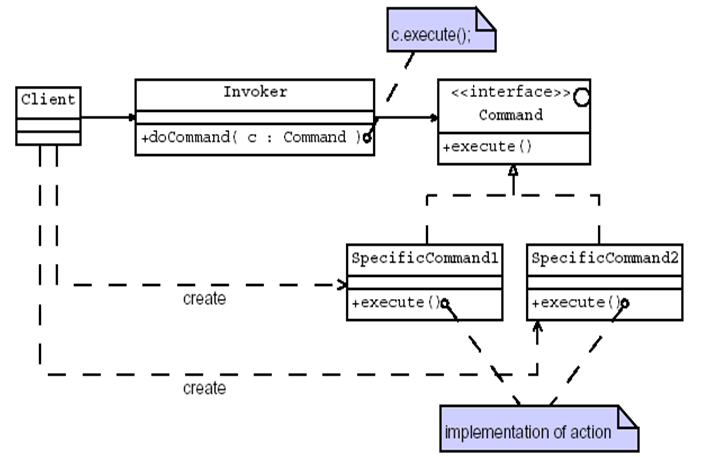
-
Glossary
ACDEGHIJLMORSTUW
A
aggregation
- A part of relationship between a component object and an aggregate object.
- Data source: Hoffer, J. George J. and Valaicich J. 1998. Modern Systems Analysis Design. 2nd Edition Addison-Wesley. ISBN:0-201-33841-6 pp. 827
application family
- A set of software application programs that have a common architecture and generic functionality. There can be tailored to the needs of specific customers by modifying components and program parameters.
- Data source: Sommerville I. 2011"Software Engineering" 9th Edition. Pearson Pp.734
application framework
- A set of reusable concrete and abstract classes that implement features common to many applications in a domain (e.g. user interface). The classes in the application framework are specialised and instantiated to create an application.
- Data source: Sommerville I. 2011"Software Engineering" 9th Edition. Pearson Pp.734
architectural pattern (style)
- An abstract description of a software architecture that has been tried and tested in a number of different software systems. The pattern description includes information about where it is appropriate to use the pattern and the organisation of the components of the architecture.
architectural view
- A description of a software architecture from a particular perspective
- Data source: Sommerville I. 2016"Software Engineering" 10th Edition. Pearson Pp.758
architecture
- Informally, a description of the organisation, motivation, and structure of a system. Many different levels of architectures are involved in developing software systems from physical hardware architecture to the logical architecture of application framework.
- Data source: Larman c. 2002 "Applying UML and Patterns", 2nd, Pearson. Pp.615
Return to TopC
class diagram
- A UML diagram types that shows the object classes in a system and their relationships. Entity classes define the functional requirements in software system.
- Data source: Sommerville I. 2016"Software Engineering" 10th Edition. Pearson Pp.759
class hierarchy
- A description of the inheritance relations between classes.
- Data source: Larman c. 2002 "Applying UML and Patterns", 2nd, Pearson. Pp.615
Client
- Note that some user-agents interpret HTML but don’t display it
Client-Server architecture
- An architectural model for distributed systems where the system functionality is offered as as set of services provided by a server. There ae accessed by client computers that make use of the services. Variants of this approach, such as three-tier client-server architectures, use multiple servers.
- Data source: Sommerville I. 2011"Software Engineering" 9th Edition. Pearson Pp.736
component
- A deployable, independent unit of software that is completely defined and accessed through a set of interfaces.
- Data source: Sommerville I. 2011"Software Engineering" 9th Edition. Pearson Pp.736
component model
- A set of standards for component implementation, documentation and deployment. These cover the specific interfaces that may be provided by a component, component naming, component interoperation, and component composition. Component models provide the basis for middleware to support executing components.
- Data source: Sommerville I. 2011"Software Engineering" 9th Edition. Pearson Pp.736-377
conceptural design
- The development of a high-level vision of a complex system and a description of its essential capabilities. Designed to be understood by people who are not systems engineers.
- Data source: Sommerville I. 2016"Software Engineering" 10th Edition. Pearson Pp.761
Configuration management
- the general process of managing a changing software system.
Return to TopD
design
- Design is a creative activity in which you identify software components and their relationships, based on a customer’s requirements.
Design models
- Design models show the objects & object classes and relationships between these entities.
design pattern
- A well-tried solution to a common problem that captures experience and good practice in a form that can be reused. It is an abstract representation than can be instantiated in a number of ways.
- Data source: Sommerville I. 2011"Software Engineering" 9th Edition. Pearson Pp. 378
domain
- A specific problem or business area where software systems are used. Examples of domains include real-time control, business data processing and telecommunications switching.
- Data source: Sommerville I. 2011"Software Engineering" 9th Edition. Pearson Pp.738
domain model
- A definition of domain abstractions, such as policies, procedures, objects, relationships and events. It serves as a base of knowledge about some problem area.
- Data source: Sommerville I. 2011"Software Engineering" 9th Edition. Pearson Pp.738
Dynamic models
- Dynamic models describe the dynamic interactions between objects.
Return to TopE
embedded system
- A software system that tis embedded in a hardware device (e.g. the software system in a mobile phone). Embedded systems are usually real-time systems and so have to respond in a timely way to events occurring in heir environment.
- Data source: Sommerville I. 2011"Software Engineering" 9th Edition. Pearson Pp.738
ER diagram
- An entity relationship diagram (ERD) shows the relationships of entity sets stored in a database. An entity in this context is a component of data. In other words, ER diagrams illustrate the logical structure of databases.
- Data source: https://www.smartdraw.com/entity-relationship-diagram/
event-based systems
- Systems where the control of operation is determined by events that are generated in the system's environment. Most real-time systems are event-based systems.
- Data source: Sommerville I. 2011 "Software Engineering" 9th Edition. Pearson Pp.739
Return to TopG
generalisation relationship
- It is kind of relationship between a more generic lcas (superclass or parent) and a more specialised kind of that class (subclass or child). The subclass is a kind of superclass. An object of the subclass ca nbe used where the superclass is allowed.
- Data source: Maciaszek, L. 2004. Requirements Anaysis and System design. Addison-wesley, ISBN: 0-321-20464-6pp.101-102
GNU Lesser General Public License (LGPL)
- The GNU Lesser General Public License (LGPL) is a variant of the GPL license where you can write components that link to open source code without having to publish the source of these components.
Ground thermometer, Anemometer, Barometer
- Application domain objects that are ‘hardware’ objects related to the instruments in the system.
Return to TopH
Host-target development Production software
- Host-target development Production software does not usually execute on the same computer as the software development environment. Rather, you develop it on one computer (the host system) and execute it on a separate computer (the target system).
Return to TopI
implementation
- Implementation is the process of realizing the design as a program.
Information system
- An informtion system is a system of communication between people. Information system are systems involved in the gathering, processing, distrution and use of information.
- Data source: Cook c. and Carber J, 2012. "Foundation HTML5 with CSS3". Springer Pp.
integrated development environment (IDE).
- "An IDE is a set of software tools that supports different aspects of software development, within some common framework and user interface. IDEs are created to support development in a specific programming language such as Java. The language IDE may be developed specially, or may be an instantiation of a general-purpose IDE, with specific language-support tools."
interaction model
- A dynamic model that shows how the system interacts with its environment as it is used.
interface
- A specification of the attributes and operations associated with a software component. The interface is used as the means of accessing the component's functionality.
- Data source: Sommerville I. 2011"Software Engineering" 9th Edition. Pearson Pp.739
internet
- A set of interconnected computer newtworks distributed around the globe
- Data source: Cook c. and Carber J, 2012. "Foundation HTML5 with CSS3". Springer Pp.
Return to TopJ
Junit
- JUnit is a unit testing framework for Java programming language. JUnit has been important in the development of test-driven development, and is one of a family of unit testing frameworks collectively known as xUnit, that originated with Junit”.
- Data source: http://www.tutorialspoint.com/junit/
Return to TopL
legacy system
- A socio-technical system that is useful or essential to an organisation but which has been developed using obsolete technology or methods. Because legacy systems often perform critical business functions , they have to be maintained.
- Data source: Sommerville I. 2016"Software Engineering" 10th Edition. Pearson Pp.765
License management
- Establish a system for maintaining information about open-source components that are downloaded and used
Return to TopM
model-driven development (MDD)
- An approach to software engineering centred around system models that are expressed in the UML. Rather than programming language code. This extends MDA to consider activities other than development such as requirements engineering and testing.
- Data source: Sommerville I. 2011"Software Engineering" 9th Edition. Pearson Pp.741
Return to TopO
object class
- An object class defines that attributes and operations of objects. Objects are created at run-time by instantiating the class definition. The object class name can be used as a type name in some object-oriented language.
- Data source: Sommerville I. 2011 "Software Engineering" 9th Edition. Pearson Pp.741
object model
- A model of a software system that is structured and organised as a set of object classes and the relationships between these classes. Various different perspectives on the model may exist such s a state perspective and a sequence perspective.
- Data source: Sommerville I. 2011 "Software Engineering" 9th Edition. Pearson Pp.742
object-oriented (OO) development
- An approach to software development where the fundamental abstractions in the system are independent objects. The same type of abstraction is used during specification, design and development
- Data source: Sommerville I. 2011 "Software Engineering" 9th Edition. Pearson Pp.741
OOP
- Object-oriented programming (OOP) is a programming language model organized around objects rather than "actions" and data rather than logic. Historically, a program has been viewed as a logical procedure that takes input data, processes it, and produces output data.
- Data source: http://searchsoa.techtarget.com/definition/object-oriented-programming
Open source development
- Open source development is an approach to software development in which the source code of a software system is published and volunteers are invited to participate in the development process
Return to TopR
requirement management
- The process of managing changes to requirements to ensurethat the changes made are properly nalyzed and tracked through the system
- Data source: Sommerville I. 2016 "Software Engineering" 10th Edition. Pearson Pp.769
resure
- Reuse Most modern software is constructed by reusing existing components or systems. When you are developing software, you should make as much use as possible of existing code.
Reuse levels
- abstraction level ; object level ;component level ; system level
Return to TopS
server
- "The computer that serves data to the client is, not surprisingly, known as a server. The Internet is riddled with servers, all storing and processing data and delivering it in response to client requests."
Sequence models
- Sequence models that show the sequence of object interactions.
software architecture
- A model of the fundamental structure and organisation of a software system
- Data source: Sommerville I. 2011"Software Engineering" 9th Edition. Pearson Pp.747
Software design and implementation
- It is the stage in the software engineering process at which an executable software system is developed.
software development life cycle
- often used as another name for the software process; originally coined to refer to the watherfall model of the software process.
- Data source: Cook c. and Carber J, 2012. "Foundation HTML5 with CSS3". Springer Pp.
State machine models
- State machine models that show how individual objects change their state in response to events.
Structural models
- Structural models describe the static structure of the system in terms of object classes and relationships.
Structured object-oriented design processes
- It involve developing a number of different system models and it require a lot of effort for development and maintenance of these models and, for small systems, this may not be cost-effective.
Subsystem models
- Subsystem models that show logical groupings of objects into coherent subsystems.
system context model
- A structural model that demonstrates the other systems in the environment of the system being developed.
Return to TopT
The Berkley Standard Distribution (BSD) License
- "This is a non-reciprocal license, which means you are not obliged to re-publish any changes or modifications made to open source code. You can include the code in proprietary systems that are sold."
The GNU General Public License (GPL).
- "This is a so-called ‘reciprocal’ license that means that if you use open source software that is licensed under the GPL license, then you must make that software open source."
Tomcat
- lThe middle tier uses a server called Tomcat that can serve Web pages and can also execute code in response to client requests.
Return to TopU
use-case diagram
- a uml diagram type that is used to identify use-cases and graphically depict the users involved. It must be supplemented with additional information to completely describe use-cases.
- Data source: Sommerville I. 2016 "Software Engineering" 10th Edition. Pearson Pp.773
user interface design
- The process of designing the way in which system users can access system functionality, and the way that information produced by the system is displayed.
- Data source: Sommerville I. 2011 "Software Engineering" 9th Edition. Pearson Pp.746
user interface design
- the process of designing the way in which system users can access system functionality, and the way that information produced by the system is displayed.
- Data source: Sommerville I. 2016 "Software Engineering" 10th Edition. Pearson Pp.774
Return to TopW
Weather data
- Encapsulates the summarized data from the instruments.
Weather station
- The basic interface of the weather station to its environment. It therefore reflects the interactions identified in the use-case model.
web service
- An independent software component that can be accessed through the internet using standard protocols. It is completely self-contained without external dependencies. XML-based standards such as SOAP (standard Object Access Protocol), for web service information exchange, and WSDL (Web Service Definition language), for the definition of web service interfaces, have been developed. However, the REST approach may also be used for web service implementation.
- Data source: Sommerville I. 2011 "Software Engineering" 9th Edition. Pearson Pp.748
Return to Top